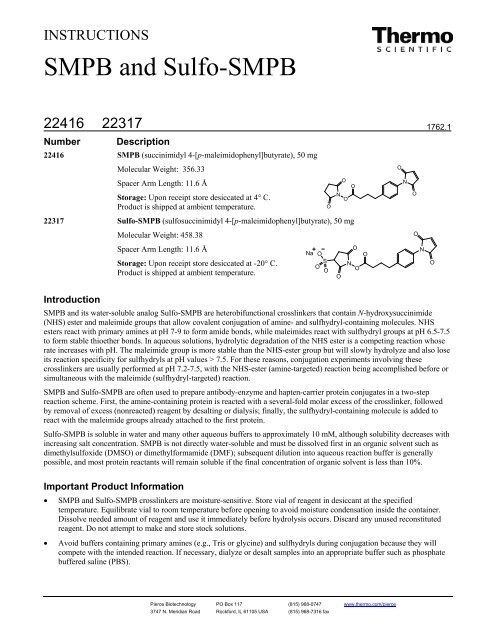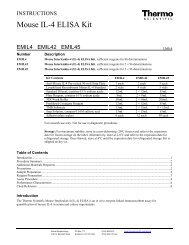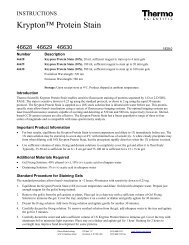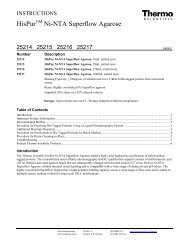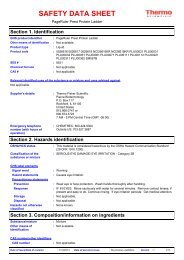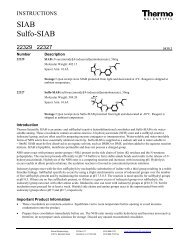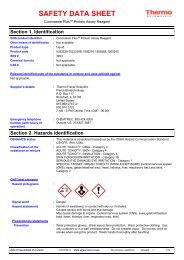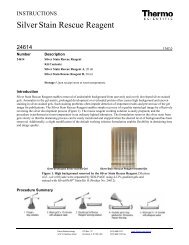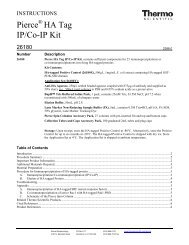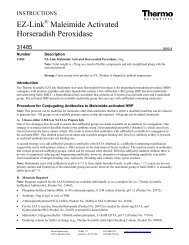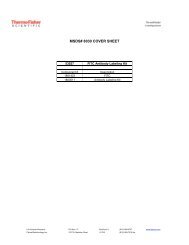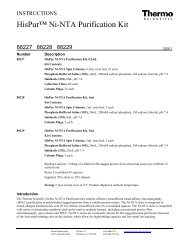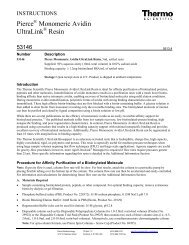SMPB and Sulfo-SMPB - Pierce
SMPB and Sulfo-SMPB - Pierce
SMPB and Sulfo-SMPB - Pierce
You also want an ePaper? Increase the reach of your titles
YUMPU automatically turns print PDFs into web optimized ePapers that Google loves.
INSTRUCTIONS<br />
<strong>SMPB</strong> <strong>and</strong> <strong>Sulfo</strong>-<strong>SMPB</strong><br />
22416 22317<br />
1762.1<br />
Number Description<br />
22416 <strong>SMPB</strong> (succinimidyl 4-[p-maleimidophenyl]butyrate), 50 mg<br />
Molecular Weight: 356.33<br />
O<br />
Spacer Arm Length: 11.6 Å<br />
O<br />
N<br />
Storage: Upon receipt store desiccated at 4° C.<br />
O<br />
Product is shipped at ambient temperature.<br />
O<br />
22317 <strong>Sulfo</strong>-<strong>SMPB</strong> (sulfosuccinimidyl 4-[p-maleimidophenyl]butyrate), 50 mg<br />
Molecular Weight: 458.38<br />
Spacer Arm Length: 11.6 Å<br />
O<br />
N<br />
O<br />
O<br />
Storage: Upon receipt store desiccated at -20° C.<br />
Product is shipped at ambient temperature.<br />
Na<br />
O<br />
S<br />
O<br />
O<br />
O<br />
N<br />
O<br />
O<br />
O<br />
N<br />
O<br />
Introduction<br />
<strong>SMPB</strong> <strong>and</strong> its water-soluble analog <strong>Sulfo</strong>-<strong>SMPB</strong> are heterobifunctional crosslinkers that contain N-hydroxysuccinimide<br />
(NHS) ester <strong>and</strong> maleimide groups that allow covalent conjugation of amine- <strong>and</strong> sulfhydryl-containing molecules. NHS<br />
esters react with primary amines at pH 7-9 to form amide bonds, while maleimides react with sulfhydryl groups at pH 6.5-7.5<br />
to form stable thioether bonds. In aqueous solutions, hydrolytic degradation of the NHS ester is a competing reaction whose<br />
rate increases with pH. The maleimide group is more stable than the NHS-ester group but will slowly hydrolyze <strong>and</strong> also lose<br />
its reaction specificity for sulfhydryls at pH values > 7.5. For these reasons, conjugation experiments involving these<br />
crosslinkers are usually performed at pH 7.2-7.5, with the NHS-ester (amine-targeted) reaction being accomplished before or<br />
simultaneous with the maleimide (sulfhydryl-targeted) reaction.<br />
<strong>SMPB</strong> <strong>and</strong> <strong>Sulfo</strong>-<strong>SMPB</strong> are often used to prepare antibody-enzyme <strong>and</strong> hapten-carrier protein conjugates in a two-step<br />
reaction scheme. First, the amine-containing protein is reacted with a several-fold molar excess of the crosslinker, followed<br />
by removal of excess (nonreacted) reagent by desalting or dialysis; finally, the sulfhydryl-containing molecule is added to<br />
react with the maleimide groups already attached to the first protein.<br />
<strong>Sulfo</strong>-<strong>SMPB</strong> is soluble in water <strong>and</strong> many other aqueous buffers to approximately 10 mM, although solubility decreases with<br />
increasing salt concentration. <strong>SMPB</strong> is not directly water-soluble <strong>and</strong> must be dissolved first in an organic solvent such as<br />
dimethylsulfoxide (DMSO) or dimethylformamide (DMF); subsequent dilution into aqueous reaction buffer is generally<br />
possible, <strong>and</strong> most protein reactants will remain soluble if the final concentration of organic solvent is less than 10%.<br />
Important Product Information<br />
<strong>SMPB</strong> <strong>and</strong> <strong>Sulfo</strong>-<strong>SMPB</strong> crosslinkers are moisture-sensitive. Store vial of reagent in desiccant at the specified<br />
temperature. Equilibrate vial to room temperature before opening to avoid moisture condensation inside the container.<br />
Dissolve needed amount of reagent <strong>and</strong> use it immediately before hydrolysis occurs. Discard any unused reconstituted<br />
reagent. Do not attempt to make <strong>and</strong> store stock solutions.<br />
<br />
Avoid buffers containing primary amines (e.g., Tris or glycine) <strong>and</strong> sulfhydryls during conjugation because they will<br />
compete with the intended reaction. If necessary, dialyze or desalt samples into an appropriate buffer such as phosphate<br />
buffered saline (PBS).<br />
<strong>Pierce</strong> Biotechnology PO Box 117 (815) 968-0747 www.thermo.com/pierce<br />
3747 N. Meridian Road Rockford, lL 61105 USA (815) 968-7316 fax
Molecules to be reacted with the maleimide moiety must have free (reduced) sulfhydryls. Reduce peptide disulfide bonds<br />
with Immobilized TCEP Disulfide Reducing Gel (Product No. 77712). Reduce disulfide bonds in high molecular weight<br />
proteins using 5 mM TCEP (1:100 dilution of Bond-Breaker ® TCEP Solution, Product No. 77720) for 30 minutes at<br />
room temperature, followed by two passes through an appropriate desalting column (e.g., Zeba Desalt Spin Columns).<br />
Be aware that proteins (e.g., antibodies) may be inactivated by complete reduction of disulfide bonds they contain.<br />
Selective reduction of hinge-region disulfide bonds in IgG may be accomplished with 2-Mercaptoethylamine•HCl (2-<br />
MEA, Product No. 20408). Sulfhydryls may be added to molecules using N-succinimidyl S-acetylthioacetate (SATA,<br />
Product No. 26102) or 2-iminothiolane•HCl (Traut’s Reagent, Product No. 26101), which modify primary amines.<br />
Procedure for Two-step Protein Crosslinking<br />
Generally, a 10- to 50-fold molar excess of crosslinker over the amount of amine-containing protein results in sufficient<br />
maleimide activation to enable several sulfhydryl-containing proteins to be conjugated to each amine-containing protein.<br />
More dilute protein solutions require greater fold molar excess of reagent to achieve the same level of activation. Empirical<br />
testing is necessary to determine activation levels <strong>and</strong> final conjugation ratios that are optimal for the intended application.<br />
A. Material Preparation<br />
Conjugation Buffer: Phosphate buffered saline (PBS, pH 7.2; e.g., Product No. 28372) or other amine- <strong>and</strong> sulfhydrylfree<br />
buffer at pH 6.5-7.5 (see Important Product Information) – adding EDTA to 1-5 mM helps to chelate divalent<br />
metals, thereby preventing disulfide formation in the sulfhydryl-containing protein<br />
<br />
Desalting column to separate modified protein from excess crosslinker <strong>and</strong> reaction byproducts (e.g., Zeba Desalt Spin<br />
Columns)<br />
<br />
Amine-containing protein (Protein-NH 2 ) <strong>and</strong> sulfhydryl-containing protein (Protein-SH) to be conjugated<br />
B. Protocol<br />
Note: For best results, ensure that Protein-SH is prepared (see Important Product Information) <strong>and</strong> ready to combine with<br />
Protein-NH 2 in step 5.<br />
1. Dissolve Protein-NH 2 in Conjugation Buffer at 0.1 mM (e.g., 5 mg in 1 ml for a 50 kDa protein).<br />
2. Add crosslinker to dissolved Protein-NH 2 at 1 mM final (= 10-fold molar excess):<br />
<br />
<br />
For <strong>Sulfo</strong>-<strong>SMPB</strong>, add 0.458 mg per milliliter of Protein-NH 2 solution or dissolve 4.58 mg <strong>Sulfo</strong>-<strong>SMPB</strong> in 1 ml<br />
Conjugation Buffer (makes 10 mM temporary stock) <strong>and</strong> immediately add 100 µl of this solution to 1 ml of<br />
Protein-NH 2 solution.<br />
For <strong>SMPB</strong>, dissolve 3.55 mg <strong>SMPB</strong> in 1 ml DMSO (makes 10 mM) <strong>and</strong> then add 100 µl of this solution to 1 ml of<br />
Protein-NH 2 solution.<br />
3. Incubate reaction mixture for 30 minutes at room temperature or 2 hours at 4°C.<br />
4. Remove excess crosslinker using a desalting column equilibrated with Conjugation Buffer.<br />
Note: Follow the desalting column product instructions to determine which fractions contain Protein-NH 2 . Alternatively,<br />
locate the protein by measuring for fractions having peak absorbance at 280 nm; however, be aware that the NHS-ester<br />
leaving group also absorbs strongly at 280 nm.<br />
5. Combine <strong>and</strong> mix Protein-SH <strong>and</strong> desalted Protein-NH 2 in a molar ratio corresponding to that desired for the final<br />
conjugate <strong>and</strong> consistent with the relative number of sulfhydryl <strong>and</strong> activated amines that exist on the two proteins.<br />
6. Incubate the reaction mixture at room temperature for 30 minutes or 2 hours at 4°C.<br />
Note: Generally, there is no harm in allowing the reaction to proceed for several hours or overnight, although usually the<br />
reaction will be complete in the specified time. To stop the conjugation reaction before completion, add buffer<br />
containing reduced cysteine at a concentration several times greater than the sulfhydryls of Protein-SH.<br />
Note: Conjugation efficiency may be estimated by electrophoresis separation <strong>and</strong> subsequent protein staining.<br />
<strong>Pierce</strong> Biotechnology PO Box 117 (815) 968-0747 www.thermo.com/pierce<br />
3747 N. Meridian Road Rockford, lL 61105 USA (815) 968-7316 fax<br />
2
Related Thermo Scientific Products<br />
Table 1. Noncleavable NHS/Maleimide crosslinkers.<br />
Crosslinker<br />
Name<br />
Spacer Arm<br />
Length (Å)<br />
Spacer Arm Composition<br />
(between ester <strong>and</strong> maleimide)<br />
Product No.<br />
(NHS)<br />
Product No.<br />
(<strong>Sulfo</strong>-NHS)<br />
AMAS 4.4 Alkane 22295 NA<br />
BMPS 5.9 Alkane 22298 NA<br />
GMBS 7.3 Alkane 22309 22324<br />
MBS 7.3 Aromatic 22311 22312<br />
SMCC 8.3 Cyclohexane 22360 22322<br />
EMCS 9.4 Alkane 22308 22307<br />
<strong>SMPB</strong> 11.6 Alkane/Aromatic 22416 22317<br />
SMPH 14.2 Alkane/Amide 22363 NA<br />
LC-SMCC 16.2 Alkane/Amide/Cyclohexane 22362 NA<br />
KMUS 16.3 Alkane NA 21111<br />
Product References<br />
1. Martin, F.J. <strong>and</strong> Papahadjopoulos, D. (1982). Irreversible coupling of immunoglobulin fragments to preformed vesicles. J. Biol. Chem. 257: 286-8.<br />
2. Gitman, A.G., Kahane, I. <strong>and</strong> Loyter, A. (1985). Use of virus-attached antibodies or insulin molecules to mediate fusion between Sendai virus<br />
envelopes <strong>and</strong> neuraminidase-treated cells. Biochemistry 24: 2762-8.<br />
3. Gitman, A.G., Graessmann, A. <strong>and</strong> Loyter, A. (1985). Targeting of loaded Sendai virus envelopes by covalently attached insulin molecules to virus<br />
receptor-depleted cells: fusion-mediated microinjection of ricin A <strong>and</strong> simian virus 40 DNA. Proc. Natl. Acad. Sci. USA 82: 7309-13.<br />
4. Bangs, J.D., et al. (1986). Posttranslational modification <strong>and</strong> intracellular transport of a typanosome variant surface glycoprotein. J. Cell Biol. 103:<br />
255-63.<br />
5. Teale, J.M. <strong>and</strong> Kearney, J.F. (1986). Clonotypic analysis of the fetal B cell repertoire: evidence for an early <strong>and</strong> predominant expression of idiotypes<br />
associated with the VH 36-60 family. J. Mol. Cell. Immunol. 2: 283-92.<br />
6. Iwai, K., et al. (1988). Preparation of a verifiable peptide-protein immunogen: direction-controlled conjugation of a synthetic fragment of the monitor<br />
peptide with myoglobin <strong>and</strong> application for sequence analysis. Anal. Biochem. 171: 277-82.<br />
7. Myers, D.E., et al. (1989). The effects of aromatic <strong>and</strong> aliphatic maleimide crosslinkers on anti-CD5 ricin immunotoxins. J. Immunol. Meth. 121:129-<br />
42.<br />
8. Brinkley, M.A. (1992). A survey of methods for preparing protein conjugates with dyes, hapten <strong>and</strong> crosslinking reagents. Bioconj. Chem. 3: 2-13.<br />
9. Chamow, S.M., et al. (1992). Conjugation of soluble CD4 without loss of biological activity via a novel carbohydrate-directed crosslinking reagent. J.<br />
Biol. Chem. 267(22): 15916-22.<br />
10. Niemeyer, C.M., et al. (1994). Oligonucleotide-directed self-assembly of proteins: semisynthetic DNA-streptavidin hybrid molecules as connectors for<br />
the generation of macroscopic arrays <strong>and</strong> the construction of supramolecular bioconjugates. Nucl. Acid. Res. 22(25):5530-9.<br />
11. Niemeyer, C.M. et al. (1998). Hybridization characteristics of biomolecular adaptors, covalent DNA-streptavidin conjugates. Bioconjugate Chemistry<br />
9(2): 168-75.<br />
12. Adessi, C., et al. (2000). Solid phase DNA amplification: characterization of primer attachment <strong>and</strong> amplification mechanisms. Nucl. Acid Res.<br />
28(20):e87.<br />
13. D’Oro, U., et al. (2002). Regulation of constitutive TCR internalization by the ζ-chain. J. Immunol. 169:6269-78.<br />
14. Wang, X-Q., Sun, P. <strong>and</strong> Paller, A.S. (2002). Ganglioside induces caveolin-1 redistribution <strong>and</strong> interaction with the epidermal growth facto receptor. J.<br />
Biol. Chem. 277(49): 47028-34.<br />
15. Chen, Z., et al. (2003). Spatial <strong>and</strong> dynamic interactions between phospholamban <strong>and</strong> the canine cardiac Ca 2+ pump revealed with use of<br />
heterobifunctional crosslinking agents. J. Biol. Chem. 278(48): 48348-56.<br />
16. Goldoni, S., et al. (2004). Biologically active decorin is a monomer in solution. J. Biol. Chem. 279(8): 6606-12.<br />
17. Mamedova, A.A., et al. (2004). Substrate-induced conformational change in bacterial complex I. J. Biol. Chem. 279(22): 23830-6.<br />
<strong>Pierce</strong> Biotechnology PO Box 117 (815) 968-0747 www.thermo.com/pierce<br />
3747 N. Meridian Road Rockford, lL 61105 USA (815) 968-7316 fax<br />
3
This product (“Product”) is warranted to operate or perform substantially in conformance with published Product specifications in effect at the time of sale,<br />
as set forth in the Product documentation, specifications <strong>and</strong>/or accompanying package inserts (“Documentation”) <strong>and</strong> to be free from defects in material <strong>and</strong><br />
workmanship. Unless otherwise expressly authorized in writing, Products are supplied for research use only. No claim of suitability for use in applications<br />
regulated by FDA is made. The warranty provided herein is valid only when used by properly trained individuals. Unless otherwise stated in the<br />
Documentation, this warranty is limited to one year from date of shipment when the Product is subjected to normal, proper <strong>and</strong> intended usage. This<br />
warranty does not extend to anyone other than the original purchaser of the Product (“Buyer”).<br />
No other warranties, express or implied, are granted, including without limitation, implied warranties of merchantability, fitness for any particular<br />
purpose, or non infringement. Buyer’s exclusive remedy for non-conforming Products during the warranty period is limited to replacement of or<br />
refund for the non-conforming Product(s).<br />
There is no obligation to replace Products as the result of (i) accident, disaster or event of force majeure, (ii) misuse, fault or negligence of or by Buyer, (iii)<br />
use of the Products in a manner for which they were not designed, or (iv) improper storage <strong>and</strong> h<strong>and</strong>ling of the Products.<br />
Current versions of product instructions are available at www.thermo.com/pierce. For a faxed copy, call 800-874-3723 or contact your local distributor.<br />
© 2010 Thermo Fisher Scientific Inc. All rights reserved. Unless otherwise indicated, all trademarks are property of Thermo Fisher Scientific Inc. <strong>and</strong> its<br />
subsidiaries. Printed in the USA.<br />
<strong>Pierce</strong> Biotechnology PO Box 117 (815) 968-0747 www.thermo.com/pierce<br />
3747 N. Meridian Road Rockford, lL 61105 USA (815) 968-7316 fax<br />
4


